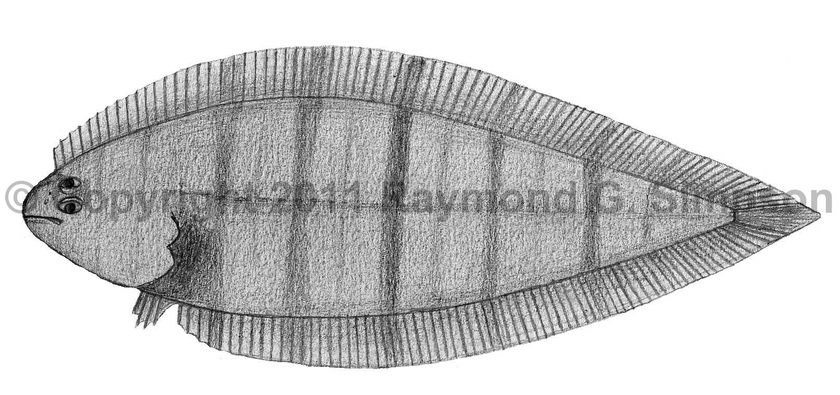
Common Name
Northern Tonguefish
Year Described
Goode and Bean, 1885
Identification
Dorsal Fin Rays: 83-88
Anal Fin Rays: 71-75
Pectoral Fin Rays: none
Pelvic Fin Rays: 4
Caudal Fin Rays: 12
Longitudinal Scale Rows: 77-87
Vertebrae: 47-49
Pterygiophore pattern (1st three interneural spaces): 1-3-2
Other diagnostic characters include: pupillary operculum absent, teeth on anterior 3/4 (occasionally entire) of ocular side premaxilla, entire dentary with a single row of teeth, ocular side lower jaw without fleshy ridge, and scales absent from blind side dorsal and anal fins.
Color
Yellowish with 2-6 brown crossbands (only a few being dark). No caudal blotch. A V-shaped line of dark melanophores on head between eyes. Specimens without scales show dark dermal melanophores at the base of the dorsal fin and along the vertebral column. Dorsal and anal fins dusky basally or mottled corresponding to body banding. Peritoneum black. Blind side pale without melanophores.
Size
Adults usually from 38-55mm. Maximum size to 77mm.
Habitat
Continental shelf from 102-233m, over mud bottoms.
Range Map

Range
Off the U.S. from off Long Island to S. Florida, and the eastern Gulf of Mexico.
References
Munroe, T.A. 1998. Systematics and ecology of western Atlantic tonguefishes (Symphurus: Cynoglossidae: Pleuronectiformes). Fish. Bull. 96(1):1-182.
Munroe, T. A. 2003. Bothidae (Pp. 1885-1895), Scophthalmidae (Pp. 1896-1897), Paralichthyidae (Pp. 1898-1921), Poecilopsettidae (Pp. 1922-1923), Achiridae (Pp. 1925-1933), Cynoglossidae (Pp. 1934-1959). In: Carpenter. 2003. The living marine resources of the Western Central Atlantic v. 3.